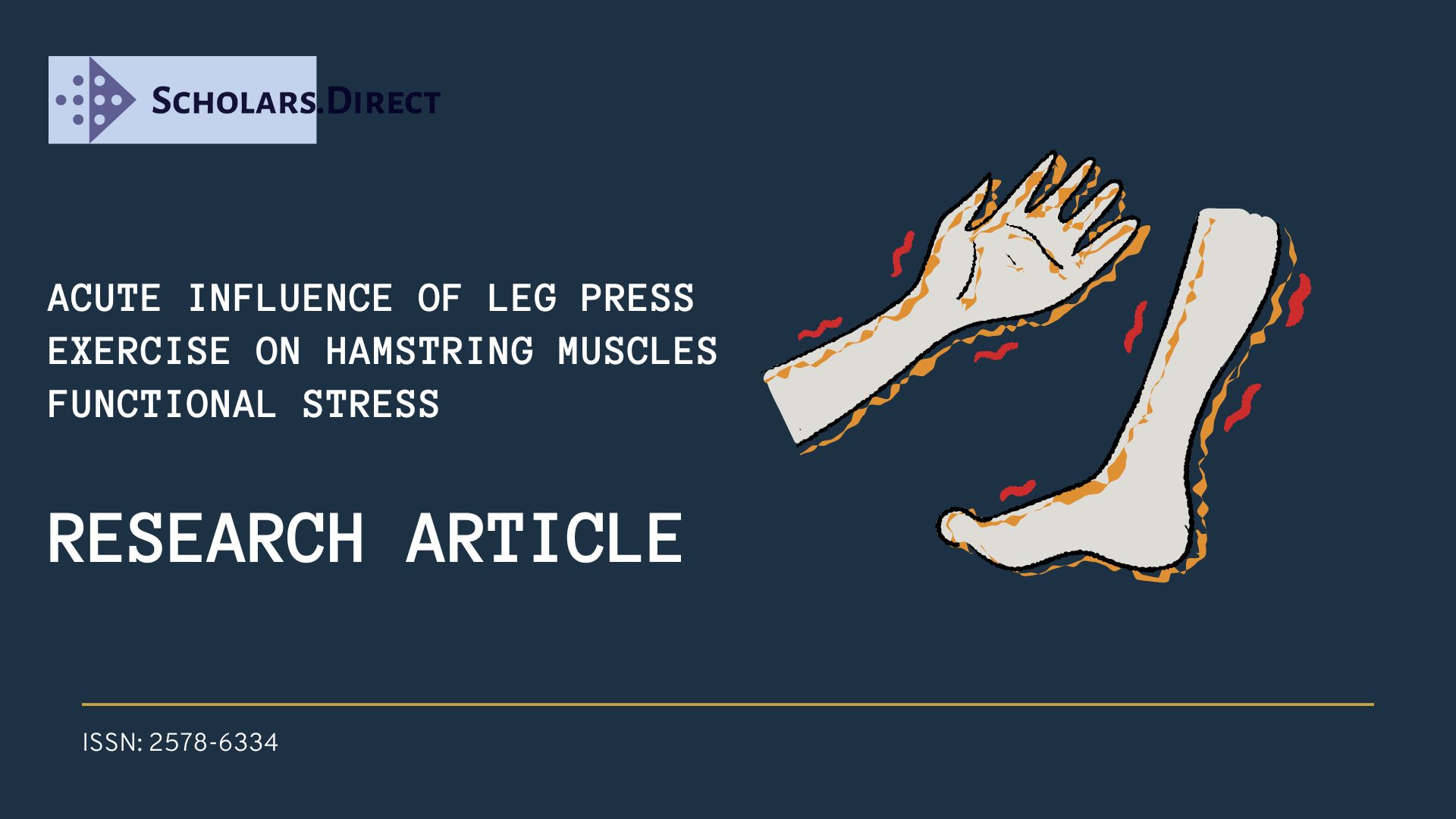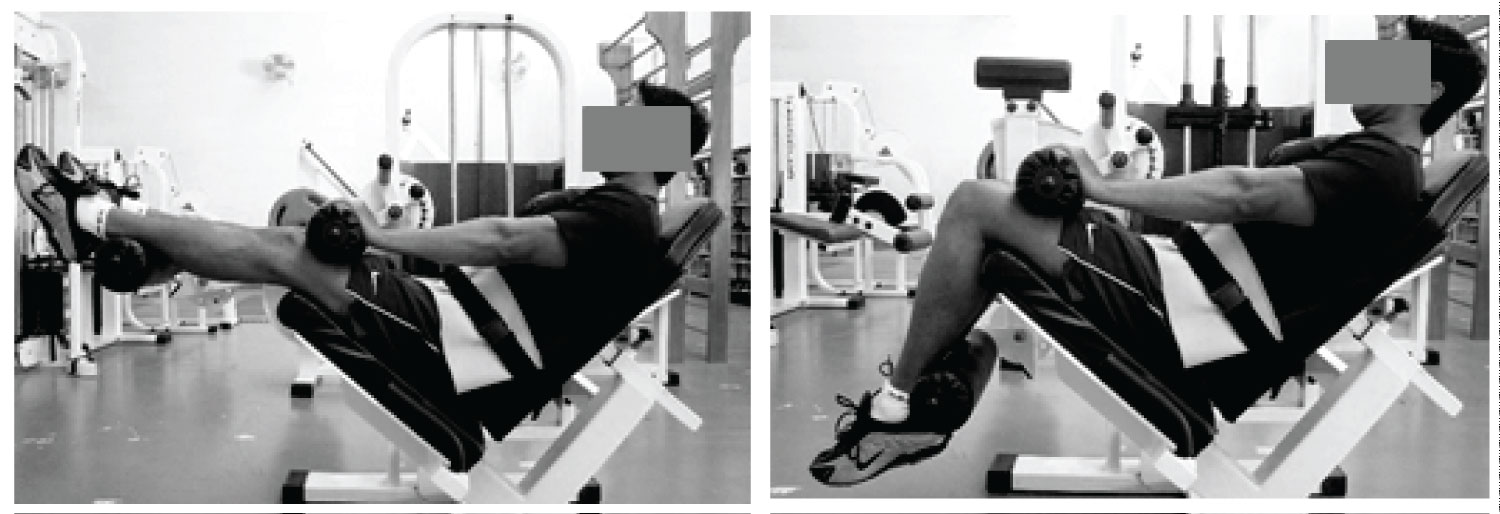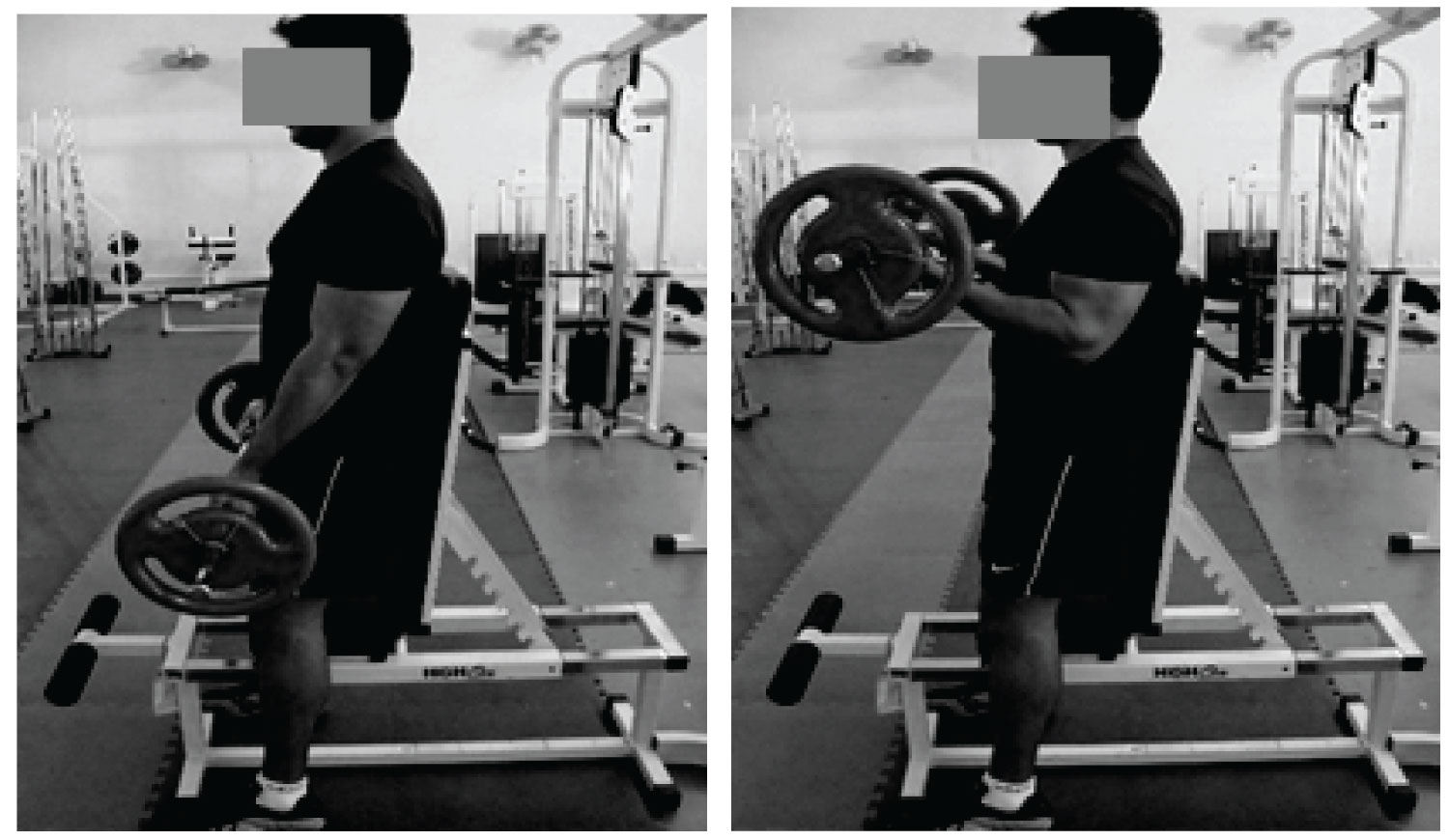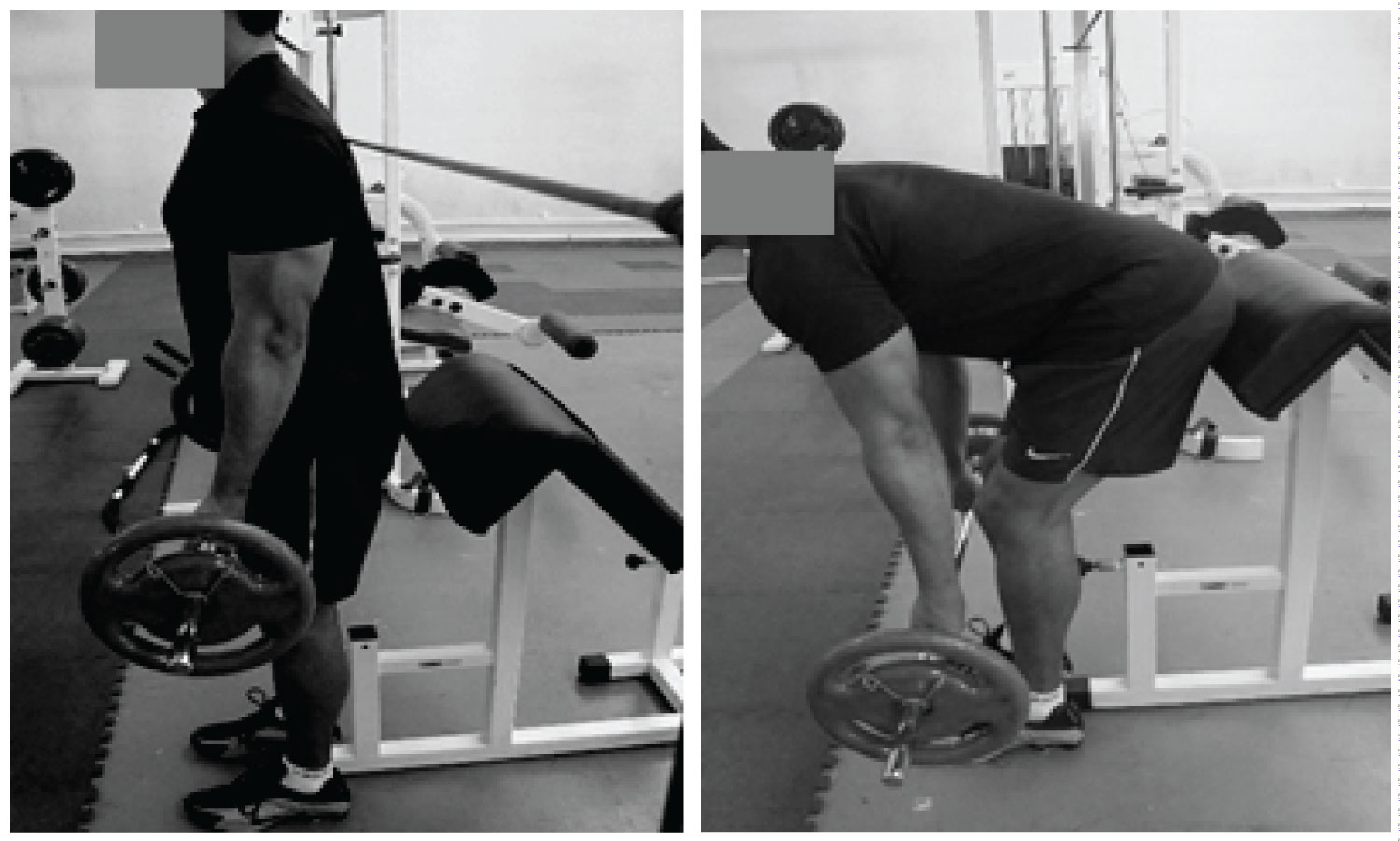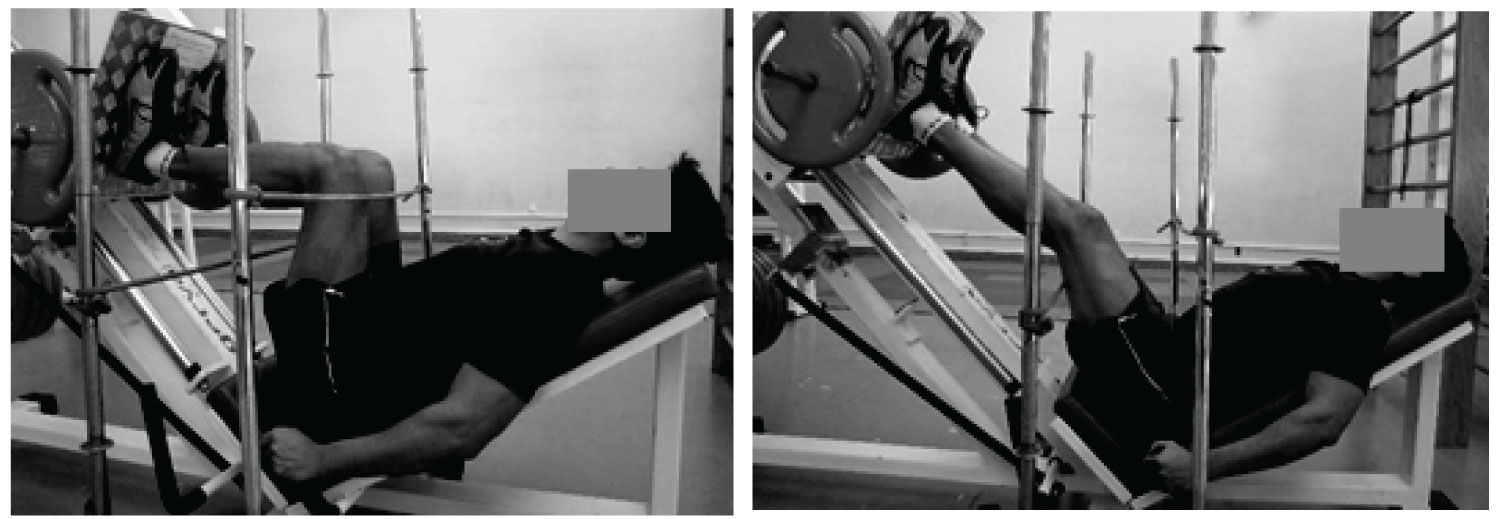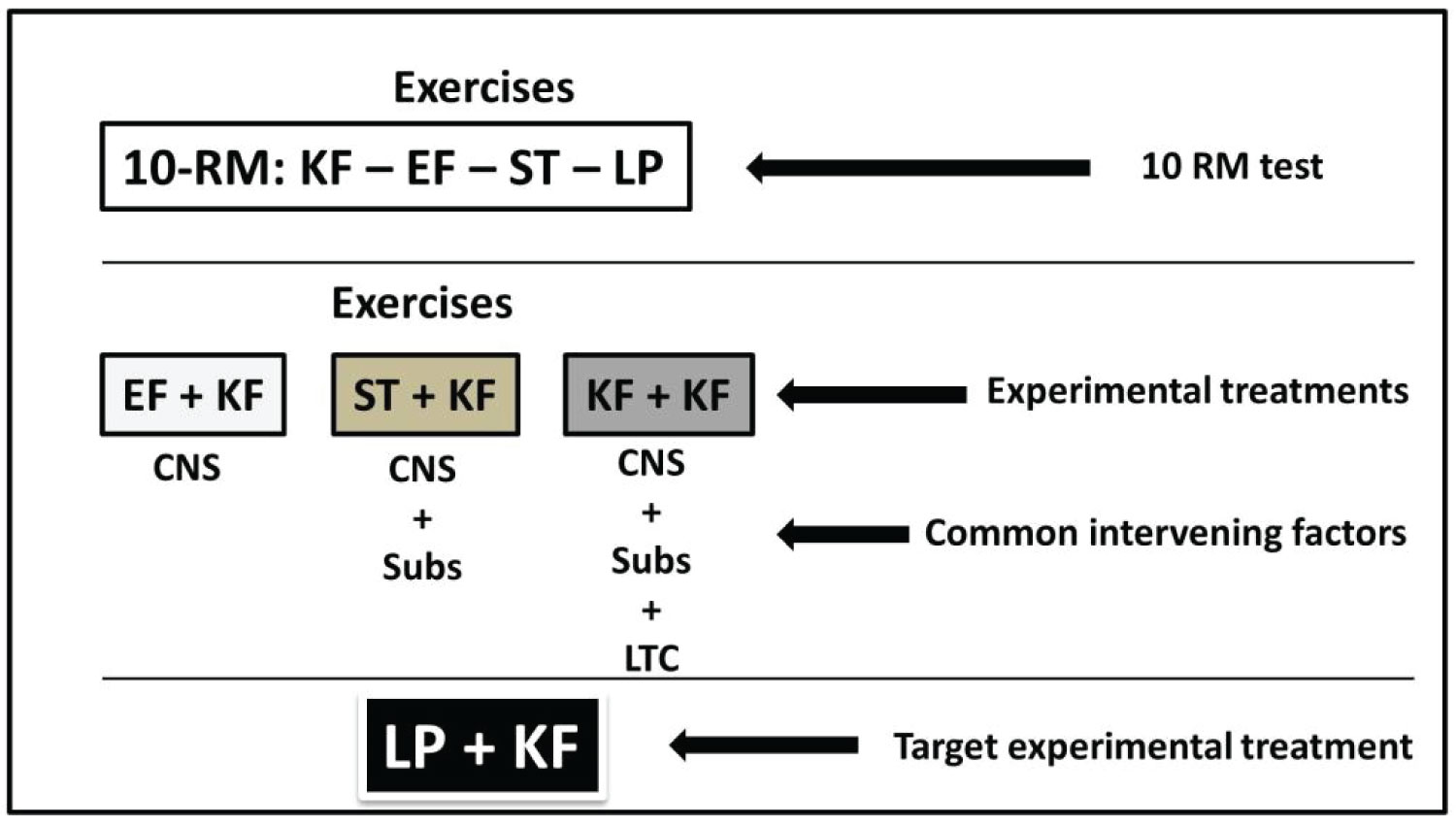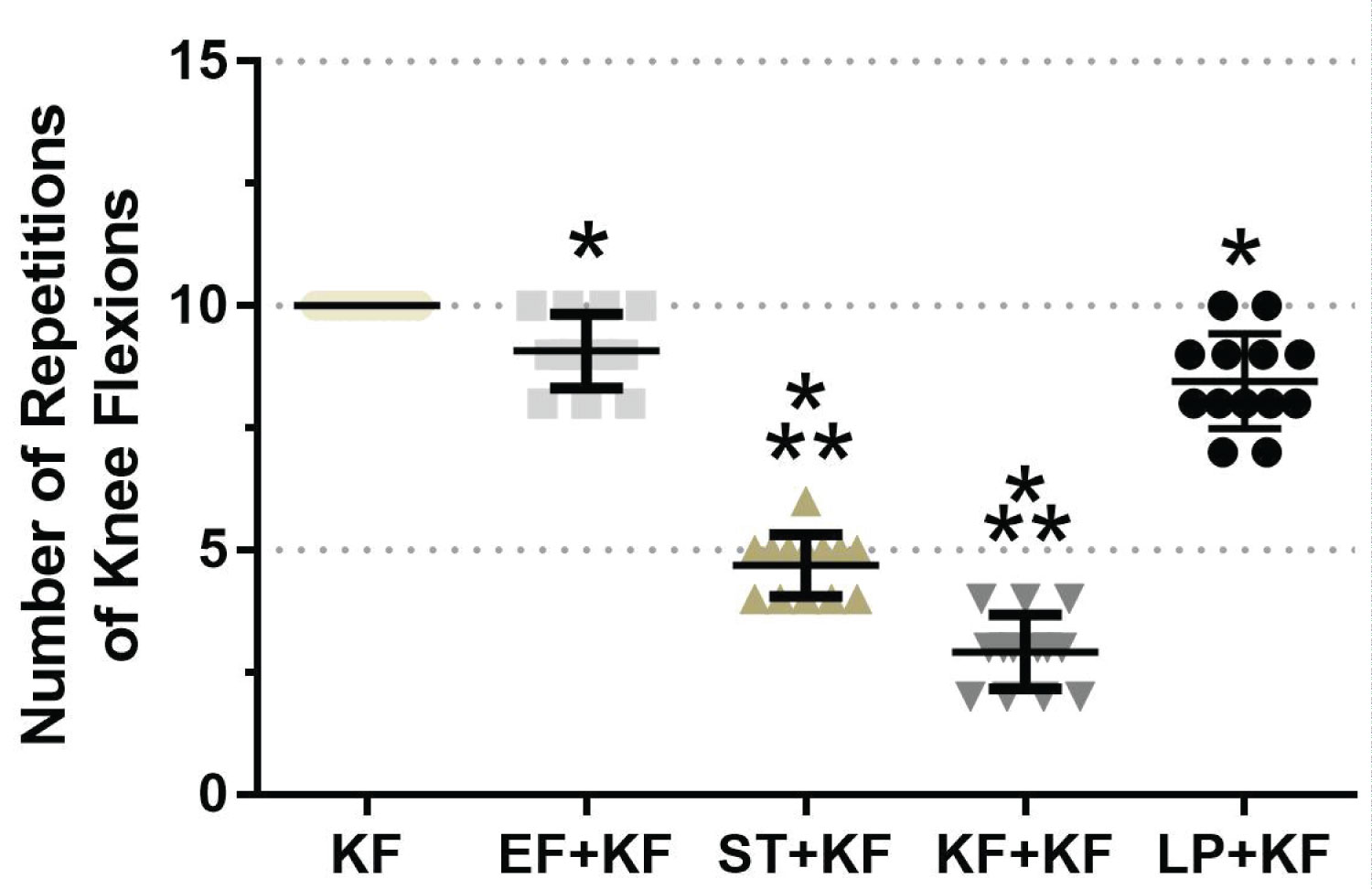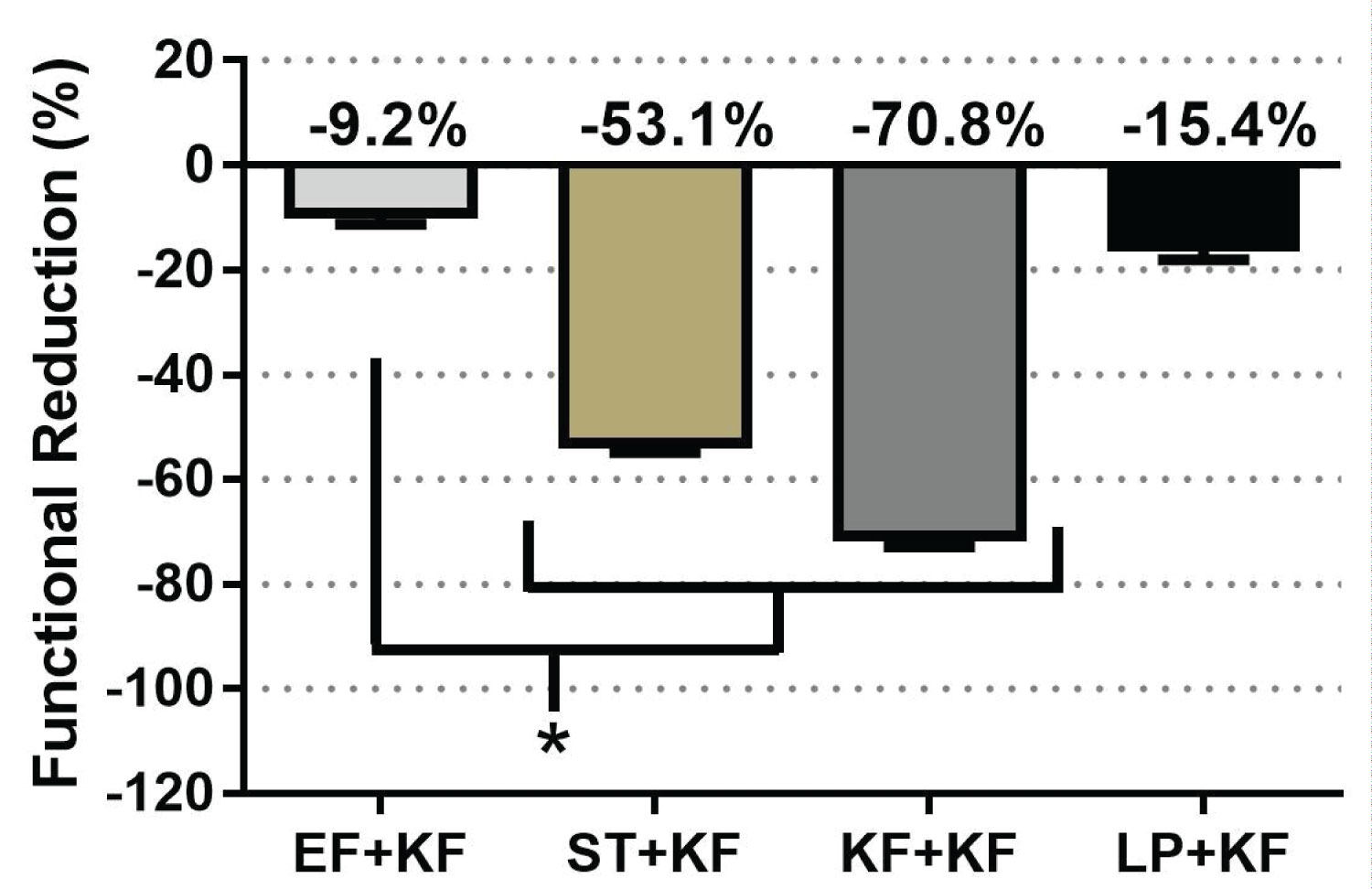Acute Influence of Leg Press Exercise on Hamstring Muscles Functional Stress
Abstract
Propuse: The objective was to verify the acute influence of the Leg Press 45° (LP) exercise on the functional stress of the hamstring muscles, through a test of maximum repetitions in 13 men.
Methods: Four different situations of the stress of the previous hamstring muscles were induced by the combination of the LP, Knee Flexor (KF), Stiff (ST) and Elbow Flexion (EF) exercises, to measure the level of reduction of the hamstring muscles functional capacity after each exercise and compares them to the LP. The procedures consisted of performing the KF exercise 10s after the execution of the EF, and KF 10s after the execution of the ST, and KF 10s after the execution of the KF itself, and FJ 10 s after the execution of the LP.
Results: The functional stress of the hamstring muscles caused by the execution of the four exercises subsequently (10s) to the execution of the KF was: EF = 9.2%, ST = 53.1%, KF = 70.8% and LP = 15.4%. When comparing functional reductions between exercises, we found a significant difference between LP and ST (p = 0.001) and between LP and KF (p = 0.001). However, the reduction was not significant when comparing the LP and EF (p = 0.414). The ST also showed a significant difference for the KF (p = 0.001) and for the EF (p = 0.001).
Conclusion: The level of functional reduction of hamstring muscles in the execution of the leg press 45° was similar to that verified in EF, both being significantly lower than the functional reductions in ST and in the KF itself.
Keywords
Hamstrings muscles, Strength training, Muscle function, Performance
Introduction
The use of differentiated techniques allows reaching various levels of recruitment of motor units, in an attempt to produce optimal gains in strength, functionality, and muscle hypertrophy. However, changes in the rate of knee extension and flexion strength between different sports are observed [1], which can expose the referred joint to a higher risk of injury [2].
One of the adaptations to resistance training (RT) is the increase in performance in the strength levels. However, some aspects directly influence the performance and, consequently, the acute adaptations to the TR [3]. Among them, we highlight the mechanisms of central and/or peripheral fatigue [4]; the reduction of the substrate reserves inside the muscle, especially the phosphorylated glucose reserves [5]; the behavior of the resistance applied by the exercise related to the length-tension curve [6]; and the mechanical characteristics of the exercises [6]. These factors must be associated with the level of demand that each exercise causes in the different muscle groups, having as a cause "residual fatigue" and, as a consequence, the reduction of the functional capacity of each muscle group involved. Studie by Brennecke, et al. [7], indicate that one of the effects of fatigue (central and/or peripheral) is the functional and electromyographic changes in the muscles involved in knee extension and hip extension, during the execution of the pre-exhaustion method. Augustsson, et al. [8], observed the influence of pre-exhaustion, verified by the performance in the knee extensor (KE) exercise followed by the leg press (LP), checking a significant drop in the electromyographic activity and the volume of maximum repetitions (RM) of the muscles of the lower limbs, when compared to performing the same exercise in an "isolated" manner.
Mechanical models [9], electromyographic techniques [10], magnetic resonance [11], and computed tomography [12] are used to check chronic or acute adaptations of muscles in the LP exercise, to more accurately identify the muscle functions. Several muscles participate in the execution of the exercise LP (quadriceps and gluteus maximus), hamstrings (biceps femoris, semimembranosus, and semitendinosus), triceps sural, among others, with different functions [13]. However, some authors [14,15] suggest that for there to be increases in protein synthesis of muscle fibers, it is necessary that, in addition to being recruited, they must be subjected to a certain level of functional stress or mechanical load. Data from Escamilla, et al. [10], using the electromyography technique, are divergent about variations in the position of the feet in the LP and the muscular action of the hamstrings and quadriceps. Probably, due to the types of equipment used and the limitation of the technique for this type of inference.
There is no consensus in the literature for the conceptualization of muscle functions, as well as for the relevance of the participation of hamstring muscles in multi-joint exercises for the priority training of the quadriceps, specifically, in exercise the leg press 45°. As a result, professionals who use RT for their actions may be causing joint imbalances due to the lack of knowledge of stress levels and the consequent adaptations caused by multi-joint exercises for the quadriceps, in the hamstring muscles [16].
Due to the lack of studies and methodological instruments to assess muscle performance in synergistic actions, mainly for agonist's muscles and in resistance exercises, the objective of this study was to verify, using a functional model, the magnitude of the functional stress of hamstring muscles, in exercises Elbow Flexion, Stiff, Knee Flexion and, specifically, the exercise leg press.
Materials & Methods
Subjects
A randomized and crossover study was applied in 13 subjects, male, with experience of not less than 12 months in strength training, the average age of 22 ± 3.1 years, the average body mass of 72 ± 9.0 kg, and the average height of 180 ± 7.2 cm. In order to participate, volunteers should answer the PAR-Q questionnaire negatively, not use ergogenic substances, and do not have joint or muscle problems that could interfere with performance. Volunteers who were not present for the tests, hydrated (with at least 500 ml) in the last preceding hour were excluded; they did not report being fed usually to their routines; did not report good quality on the previous night's sleep (relative to normal individual behavior), and did not commit themselves to carry out predetermined tasks. This last criterion was assessed subjectively by the movement pattern in the final repetitions of the series. As a result, a volunteer was excluded for not meeting the last criterion on the first day of tests. The research protocol (692.573/2014) was approved by the ethics and research committee of the Veiga de Almeida University, UVA-RJ, Brazil.
Procedures
After a first contact between the researchers and the volunteers, where the preliminary guidelines were explained, data collection was carried out during two visits, not consecutive, with an interval of 48 to 96 hours between them. On the first visit, the volunteers were given detailed instructions on the procedures and objectives of the research, as well as the discomforts and risks, and a free and informed consent form was signed, after individual clarifications. Completion and signing of the PAR-Q questionnaires were also promoted, followed by the definition of dates and times for the tests, adapting the collection times to the training schedules of each volunteer. After inquiring about the previous night's sleep, checking in the 48 hours without physical training, hydration and previous feeding, the volunteers were instructed to perform the test of 10 maximum repetitions (10-RM) in the Elbows Flexion (EF), Stiff (ST), Knee Flexion (KF) and Leg Press (LP) exercises. In a randomized manner, they performed a period of familiarization in the exercises and in the methods to be applied. In a randomized manner, they performed a period of familiarization in the exercises and in the methods to be applied. A previous warm-up was performed, with 3 sets of 15 repetitions for upper limbs, with intensity calculated at 10% of body mass in the first two sets and 15% for the third set, for lower limbs, respectively, 20% and 40% of body mass. The LP and KF equipment used in this study are from Gerva Sport® and Manejo®, respectively.
In order to reduce the margin of error in the 10-RM test, the following procedures were adopted: (a) Operational instructions were provided before the test so that the subject was aware of the whole routine that involved data collection; (b) The appraised was instructed on the execution technique of each exercise and that they were performed in a movement rhythm of 1.5 seconds for the concentric phase and 3 seconds for the eccentric phase of each repetition, controlled through the use of a visual metronome, positioned immediately in front of the execution site; (c) The evaluator was attentive to the position adopted by the volunteer at the time of measurement, execution, and rhythm of the exercises performed, as small variations in the joints involved in the movement could lead to erroneous interpretations of the values obtained; (d) Verbal stimuli were performed in order to maintain effort maintenance, and additional weights used in the study were previously measured on a precision scale. The values of the maximum intensities in the 10-RM test were obtained when the individual could not perform the movement with the determined amplitude and/or could not obey the rhythm of execution for two consecutive repetitions, detected through the inability to reach the final third of the test range of motion in the time given for each phase. After obtaining the intensity in a given exercise, intervals of not less than ten minutes were safeguarded, before moving on to the test in the next exercise. An appraiser trained in this type of movement control remained with the volunteer to observe the performance according to the rhythm and range of movement (ROM), verbally stimulate the maintenance of effort and limit the ROM, calibrated by specific devices. Another evaluator, with the same technical characteristics, was responsible for counting the repetitions and observing the execution technique. In all exercises, a rhythm of 1.5 seconds was used for the concentric phase and 3 seconds for the eccentric phase of each repetition, controlled by using a visual metronome. In the second meeting, the experimental treatments were carried out in a randomized manner, so that we made it possible for each treatment to be carried out in all the possibilities of ordering and, thus, minimizing the cumulative effects of previous actions, as shown in Table 1.
Initially, to confirm the intensity to perform 10-RM in the KF exercise, the volunteers performed the KF exercise without previous activity. The ROM was regulated according to Figure 1, obeying the angles of 20° and 90° of flexion for the beginning and end of the concentric actions, respectively. Thus, we assume that the CNS [17], the substrate reserves [18], and the tension-length curve [19] of the hamstrings muscles would be functionally preserved. That is, these three factors involved in muscle performance would be at maximum functional predisposition. In this execution, the volunteers were instructed to keep the ankle in plantar flexion (observing the stiffness of the tendon of the anterior tibial muscle), minimizing the help of gastrocnemius for knee flexion, as shown in Figure 1. This procedure, therefore, was the parameter adopted to characterize the highest possible functional stress to be applied to the hamstrings muscles.
In treatment one (T1), the volunteers performed the KF exercise, 10 seconds after performing the EF exercise. The ROM for EF was regulated as shown in Figure 2, keeping the humerus in an upright position, the end of the eccentric phase was regulated so that the bar approached the body as far as possible, without touching it. The upper limit of the concentric action was determined with maximum elbow flexion, keeping the humerus in the position previously determined. We assume that with this, there was previous stress of the CNS. However, the reserves of intramuscular substrates were at levels similar to those of rest (of the hamstrings), and the tension-length curve was not considered because the exercise does not involve the lower limbs.
In treatment two (T2), the volunteers performed the KF exercise, 10 seconds after performing the ST exercise. A shield was used to regulate the projection of the hip in the posterior direction, as shown in Figure 3. We assume, therefore, that there was previous stress involving the CNS and the reserves of intramuscular substrates (of the hamstrings muscles). However, due to the mechanical characteristic differentiated about knee flexion, the highest resistance torques were not applied in the same lengths as the sarcomeres.
In treatment three (T3), the volunteers performed the KF exercise, 10 seconds after performing the KF exercise. We assume, therefore, that there was previous stress involving the CNS, the reserves of intramuscular substrates (of the hamstring muscles), and a mechanical requirement at similar points on the muscle tension length curve, as shown in Figure 1.
Finally, in treatment four (T4), the volunteers performed the KF exercise 10 seconds after performing the LP exercise. The ROM for the LP was regulated in such a way that, when the femur was in an upright position, the knee was at a 90° angle. As a result, there was a variation in the position of the platform according to the body dimensions of the volunteers. However, we aim to maintain similar levels of stretching of the extensor muscles of the hip and knee, as illustrated in Figure 4. Thus, we compared the performance of the volunteers in the exercise KF, of with the other situations.
In all the exercises preceding the series in the KF exercise, the volunteers performed 10 repetitions, even though they needed to adjust one or two final repetitions about the ROM or the rhythm of execution. With that, we guarantee that the series preceding the "test series" was fulfilled in the same total work. The scheme of the methodological procedures is represented in Figure 5.
Statistical analysis
Data were analysed using SPSS software (IBM SPSS Statistics for Windows, Version 19.0.). Initially, the normality of the data was tested using the Shapiro-Wilk test, and then the data were tested using ANOVA and, for the variables that showed a significant difference, we used the Tukey Post Hoc. Effect Sizes (ES) (Cohen's d: Small effect ≥ 0.20, medium effect ≥ 0.50, large effect ≥ 0.80, very large effect ≥ 1.30) and Delta (Δ) were calculated. We adopted a significance level of ≤ 0.05.
Results
We present the results in a descriptive and inferential manner in Figure 6, according to the absolute values of the number of maximum repetitions performed in knee flexion. A significant reduction (p < 0.05) was observed in the number of repetitions performed on knee flexion in the sequences EF + KF (9.07 ± 0.75 repetitions), ST + KF (4.62 ± 0.63 repetitions), KF + KF (2.92 ± 0.75 repetitions) and LP + KF (8.46 ± 0.96 repetitions) compared to the reference KF (10 repetitions). A significant reduction (p < 0.05) was observed in the number of repetitions performed on knee flexion in the ST + KF (4.62 ± 0.63 repetitions) and KF + KF (2.92 ± 0.75 repetitions) sequences compared to EF + KF (9.07 ± 0.75 repetitions). There were no significant differences (p > 0.05) in the number of repetitions performed in the sequence LP + KF (8.46 ± 0.96 repetitions) compared to the sequence EF + KF (9.07 ± 0.75 repetitions).
Figure 7 illustrates the relative reduction (%) in the number of repetitions performed on KF, suggests the magnitude of functional stress in the hamstring muscles caused by performing the KF + KF exercise sequence compared to the EF + KF, revealing a significant reduction of 70.8% (p < 0.05). Then, we noticed a significant reduction (p < 0.05) of 53.1% caused by performing the ST + KF exercise sequence compared to the EF + KF. There was no significant difference (p > 0.05) in the performance of the LP + KF sequence (-15.4%) compared to the EF + KF performance.
Discussion
According to the results presented, we found that the physiological aspects (CNS, substrate reserves, and other metabolism components and length-tension curve) revealed a significant influence on the functional stress of the muscles involved in the exercises.
As suggested by the literature [17], because the elbow flexion exercise does not use muscles synergistic to those involved in the knee flexor exercise, there was no significant reduction in performance. This probably occurred due to the time used to perform the second exercise (10s), which must not have been short enough to cause significant reductions in the functional performance of the hamstring muscles. That is, the restoration of acetylcholine from the synapses [20] and the recovery of the cerebral cortex and the limbic system suffered [21], however, not significant impairments. According to Thau and Singh [22], in order to perform a motor action, the central nervous system must perform a sequence of four major tasks: Activation of the limbic system which translates into the level of motivation; the idea of acting, which can be understood as the goals and developments of the movements; the activation of the basal glands, the pre-motor area, the cerebellum, and the motor cortex; and, finally, the peripheral command, through the spinal nerves, for the selection of the muscles that will participate in the movement. These factors, associated with enzymatic mechanisms, especially acetylcholinesterase [20], should influence the performance in the generation of force, through the variability in the behavior of generation and transport of the electrical impulse.
When performing the stiff exercise before the knee flexion, we observed a significant difference (Figure 6) about the sequence of exercises EF + KF. It is believed that this difference was caused by the metabolic issues [20] involved in the muscle activity of the hamstring muscles, in addition to the neural issues. This is because, with this combination of exercises, there was a depression of the functional capacities of the central nervous system and the intramuscular glycogen reserves.
The analysis of the length-tension relation has traditionally been used to indirectly infer the torque relation on the muscular length [23]. There is an optimum length at which sarcomeres develop maximum tension [24]. At lengths shorter or longer than this, lower stresses are developed. This functional model, called "Length-Tension Curve," originates from the study of some sarcomeres, isolated in a force transducer, which measures the amount of tension as a function of the length of the sarcomere [25]. Changes in muscle length are capable of altering the optimal point at which the muscle generates maximum tension [24]. However, this fact does not appear to be so influential in cross-sectional events, where there is no time for such adaptations to occur.
As expected, the highest functional stress was seen when the knee flexion exercise was performed twice. In addition to the neural and metabolic aspects discussed above, both exercises require wear of the involved musculature at similar points of interaction between the sarcomeres. This fact occurs because the stresses applied over the range of motion must be the same. That is, the points where sarcomeres were most required were the same in both situations. However, although the clinical magnitude of the impairment reveals a trend, it appears that the interval between exercises (10 seconds) was ample so that the performance at T-3 and T-4 would show a statistical difference (p < 0.05).
The stress caused by the leg press to the hamstring muscles was not significant (Figure 6 and Figure 7). This phenomenon has already been enunciated as "selective recruitment" by some authors [26,27], about the reduction of tension generated by a bi-joint muscle, by opposition to the movement performed in one of the joints, such as biceps brachii in flexion of elbows in pronation [28]; the extended portion of the triceps brachii in elbow extension with shoulder flexion [29]; the maximum gluteus in the hip extension with the knee extended and in internal rotation [30]. Similar results had already been reported in chronic experiments using magnetic resonance, however, in squats [31,32].
Although they do not use the same nomenclature, recently, other authors defend the differentiated action of muscles that have this kinesiological (bi-joint) characteristic with the possibility of opposition to one of the actions performed [33,34]. Therefore, given the sarcomeres in these muscular wombs, it seems acceptable to think that their recruitment should be reduced, due to the paradox that will be created about the agonist action in one joint and antagonist in another. This phenomenon seems to be also verified in the hamstring muscle group, constituted by the muscles, biceps of the thigh, semitendinosus, and semimembranosus, which covers two joints (knee and hip), since they perform, simultaneously, the knee flexion and hip extension movements. In a longitudinal study by Hakkinen, et al. [11], ten women completed 21 weeks of training on a leg press to check for chronic adaptations in ten longitudinal regions of the quadriceps. The authors found that the three single-joint muscles showed significant increases with training, however, the Rectus Thigh muscle, which is for this exercise in a condition similar to that of the hamstrings for the leg press exercise, although not significant, even reduced its area cross-section.
Due to the magnitude of the distance from the origin of the hamstring muscles (tibial tuberosity), relative to the approach of the insertion (fibular head and lateral condyle of the femur), there is a possibility that these muscles are subjected to a stretch tension in bi-joint exercises, such as leg press, especially if there is precariousness in the range of motion of hip flexion. This phenomenon can confuse functional perception due to a mechanical cause of stretching.
Therefore, the neuromuscular factors involved in the leg press exercise, especially the selective recruitment of bi-joint muscles with functions antagonistic to the desired movement, seem to justify that the hamstring muscles are activated modestly in the leg press exercise, resulting in morphological adaptations that are also not very expressive, if these occur, as shown in some previous studies. Such findings suggest that the leg press exercise is not used under high expectations of the functional requirements of the hamstrings.
As main limitations of this study, we can mention the fact that the model used indirectly evidences the acute adaptations to the leg press exercise, comparing them to other exercises with clear and intentional differences regarding the common neuromuscular elements, as well as the care when extrapolating the findings related to the exercise leg press exercise for other multi-joint exercises, such as squats and deadlifts.
Based on the model adopted to verify the functional stress caused by various exercises for the hamstring muscles and the results presented, we conclude that the leg press exercise does not result in functional stress levels similar to those caused by specific exercises for this muscle group (knee flexion or stiff). Future studies should be carried out, using more refined technologies or more sensitive methodologies (intervals between pairs of exercises less than 10s) so that we can know more clearly the levels of acute adaptations generated by bi or multi-joint exercises for muscle training hamstrings.
Potential Conflict of Interest
No conflicts of interest with potential potential for this article have been reported.
Funding Source
There were no external sources of funding for this study.
Authors' Contributions
Conception and design of the research: Ribeiro JRC; Data collection: Tocafundo LE, Moutinho ALS; Analysis and interpretation of data: Ribeiro JRC, Sampaio-Jorge F, Morales AP; Writing of the manuscript: Ribeiro JRC, Tocafundo LE, Moutinho ALS, Sampaio-Jorge F, Ribeiro BG, Morales AP; Critical review of the manuscript for intellectually important content: Ribeiro JRC, Sampaio-Jorge F, Morales AP, Ribeiro BG.
References
- Olmo J, Lopez-Illescas A, Martin I, et al. (2006) Knee flexion and extension strength and H/Q ratio in high-level track and field athletes. Isokinetics and Exercise Science 14: 279-289.
- Fulton J, Wright K, Kelly M, et al. (2014) Injury risk is altered by previous injury: A systematic review of the literature and presentation of causative neuromuscular factors. Int J Sports Phys Ther 9: 583-595.
- (2009) Progression models in resistance training for healthy adults. Med Sci Sports Exercise 41: 687.
- Morel B, Lapole T, Liotard C, et al. (2019) Critical peripheral fatigue thresholds among different force-velocity conditions: An individual-based model approach. Front Physiol 10: 875.
- Jensen J, Rustad PI, Kolnes AJ, et al. (2011) The role of skeletal muscle glycogen breakdown for regulation of insulin sensitivity by exercise. Front Physiol 2: 112.
- Williams CD, David Williams C, Salcedo MK, et al. (2013) The length–tension curve in muscle depends on lattice spacing. Pro Biol Sci 280: 20130697.
- Brennecke A, Guimarães TM, Leone R, et al. (2009) Neuromuscular activity during bench press exercise performed with and without the preexhaustion method. J Strength Cond Res 23: 1933-1940.
- Augustsson J, Thomeé R, Hörnstedt P, et al. (2003) Effect of pre-exhaustion exercise on lower-extremity muscle activation during a leg press exercise. J Strength Cond Res 17: 411-416.
- Paoli A, Marcolin G, Petrone N (2009) The effect of stance width on the electromyographical activity of eight superficial thigh muscles during back squat with different bar loads. J Strength Cond Res 23: 246-250.
- Escamilla RF, Fleisig GS, Zheng N, et al. (2001) Effects of technique variations on knee biomechanics during the squat and leg press. Med Sci Sports Exerc 33: 1552-1566.
- Häkkinen K, Pakarinen A, Kraemer WJ, et al. (2001) Selective muscle hypertrophy, changes in EMG and force, and serum hormones during strength training in older women. J Appl Physiol 91: 569-580.
- Derstine BA, Holcombe SA, Ross BE, et al. (2021) Optimal body size adjustment of L3 CT skeletal muscle area for sarcopenia assessment. Sci Rep 11: 279.
- Stien N, Saeterbakken AH, Andersen V (2021) Electromyographic comparison of five lower-limb muscles between single- and multi-Joint exercises among trained men. J Sports Sci Med 20: 56-61.
- Damas F, Libardi CA, Ugrinowitsch C (2018) The development of skeletal muscle hypertrophy through resistance training: the role of muscle damage and muscle protein synthesis. Eur J Appl Physiol 118: 485-500.
- Mittendorfer B, Andersen JL, Plomgaard P, et al. (2005) Protein synthesis rates in human muscles: Neither anatomical location nor fibre-type composition are major determinants. J Physiol 563: 203-211.
- Orssatto LB da R, da Rosa Orssatto LB, de Moura BM, et al. (2018) Leg press exercise can reduce functional hamstring: Quadriceps ratio in the elderly. J Bodyw Mov Ther 22: 592-597.
- Fitts R H (1994) Cellular mechanisms of muscle fatigue. Physiol Rev 74: 49-94.
- Knuiman P, Hopman M T E, Mensink M (2015) Glycogen availability and skeletal muscle adaptations with endurance and resistance exercise. Nutrition and Metabolism 12: 59.
- Brughelli M, Cronin J (2007) Altering the length-tension relationship with eccentric exercise. Sports Medicine 37: 807-826.
- Picciotto MR, Higley MJ, Mineur YS (2012) Acetylcholine as a neuromodulator: Cholinergic signaling shapes nervous system function and behavior. Neuron 76: 116-129.
- Rajmohan V, Mohandas E (2007) The limbic system. Indian J Psychiatry 49: 132-139.
- Thau L, Singh P (2019) Anatomy, central nervous system. In: Stat pearls.
- Brockett CL, Morgan DL, Proske U (2001) Human hamstring muscles adapt to eccentric exercise by changing optimum length. Med Sci Sports Exerc 33: 783-790.
- Lieber RL, Ward SR (2011) Skeletal muscle design to meet functional demands. Philos Trans R Soc Lond B Biol Sci 366: 1466-1476.
- Van de Locht M, de Winter JM, Rassier DE, et al. (2020) Isolating myofibrils from skeletal muscle biopsies and determining contractile function with a nano-Newton resolution force transducer. J Vis Exp.
- Signorile JF, Applegate B, Duque M, et al. (2002) Selective recruitment of the triceps surae muscles with changes in knee angle. J Strength Cond Res 16: 433-439.
- Van Veen B, Montefiori E, Modenese L, et al. (2019) Muscle recruitment strategies can reduce joint loading during level walking. Journal of Biomechanics 97: 109368.
- Kleiber T, Kunz L, Disselhorst-Klug C (2015) Muscular coordination of biceps brachii and brachioradialis in elbow flexion with respect to hand position. Front Physiol 6: 215.
- Alves D, Matta T, Oliveira L (2018) Effect of shoulder position on triceps brachii heads activity in dumbbell elbow extension exercises. J Sports Med Phys Fitness 58: 1247-1252.
- Bae C-H, Choe Y-W, Kim M-K (2020) Effects of different external loads on the activities of the gluteus maximus and biceps femoris during prone hip extension in healthy young men. Journal of the Korean Society of Physical Medicine 15: 1-9.
- Bloomquist K, Langberg H, Karlsen S, et al. (2013) Effect of range of motion in heavy load squatting on muscle and tendon adaptations. Eur J Appl Physiol 113: 2133-2142.
- Sugisaki N, Kurokawa S, Okada J, et al. (2014) Difference in the recruitment of hip and knee muscles between back squat and plyometric squat jump. PLoS One 9: e101203.
- Shinohara M (2009) Muscle activation strategies in multiple muscle systems. Med Sci Sports Exerc 41: 181-183.
- Nozaki D (2009) Torque interaction among adjacent joints due to the action of biarticular muscles. Med Sci Sports Exerc 41: 205-209.
Corresponding Author
Jose Ricardo Claudino Ribeiro, Departamento de Processos Técnico-Científicos e Saúde - DPTS. Minas Tênis Clube, Centro Universitario de Belo Horizonte (Uni-BH), Belo Horizonte, BH, Brazil.
Copyright
© 2021 Ribeiro JRC, et al. This is an open-access article distributed under the terms of the Creative Commons Attribution License, which permits unrestricted use, distribution, and reproduction in any medium, provided the original author and source are credited.
